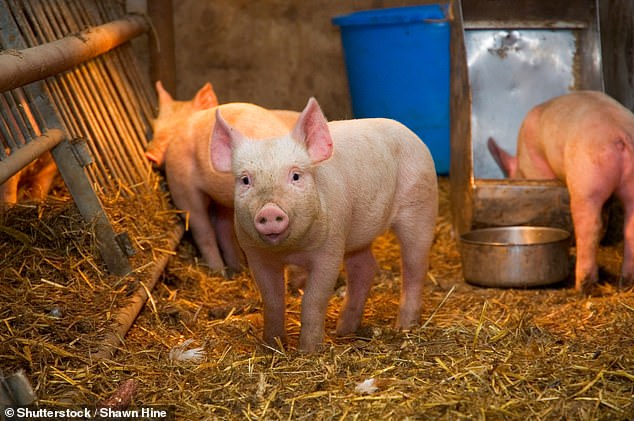Could swine flu have been spreading in the UK for nearly a MONTH? Infected Brit caught virus at start of November
Fears that swine flu had been spreading silently in Britain for three weeks were raised today after it emerged the sick Briton was ill in early November.
The North Yorkshire patient, who was struck by a strain never before seen in this country, visited his GP on November 9 with cold symptoms.
They were only tested for influenza through a “casual” winter surveillance program.
MailOnline can reveal that H1N2 was not identified as the virus responsible until laboratory results came back two weeks later.
At no point between testing the patient and receiving the result on November 23 were they forced to self-isolate.
Instead, authorities asked them to limit their contacts once the positive swab came back, according to official guidelines.
The unidentified person, believed to be from North Yorkshire, tested positive after visiting his GP with ‘respiratory symptoms’. UK Health Security (UKHSA) bosses are yet to identify how they contracted the virus. Officials are now rushing to trace all contacts of the Briton, who suffered from a ‘mild’ illness
The heads of the UK Health Security Agency (UKHSA) are still looking for all contacts of the sick Briton, who made a full recovery at home.
Officials still have no idea how the person contracted H1N2. Research is being conducted into ‘all possible transmission routes’.
MailOnline understands that the Brit has not worked with pigs.
Previous cases of H1N2 – which have been spotted 50 times worldwide over the past two decades – have been traced to national fairs in the US.
Experts fear it is “quite possible” the virus has spread silently.
Only a fraction of patients who go to the doctor with respiratory complaints, such as a runny nose and cough, are ever tested.
The surveillance program that detected the H1N2 case covers only less than a third of the more than 6,700 operations in England and Wales.
Some patients suspected of having a respiratory virus, such as the flu, have a nasal swab taken. Complex laboratory analyzes of smears often take an average of about 10 days.
Swine flu itself can lurk in the body for days before causing tell-tale symptoms, experts say.
Dr. Simon Clarke, a microbiologist from the University of Reading, told MailOnline: ‘It is entirely possible that the disease could have spread during that time.
“We don’t know how efficiently or to whom, but if this strain is transmitted efficiently to humans, it could have spread quite widely.”
Professor Gary McLean, an immunologist at London Metropolitan University, added: ‘SThe symptoms do not appear to be very serious and the outbreak is not unexpected.
‘Probably more worrying is how this person in Yorkshire acquired the infection as there was no contact with pigs.
‘This indicates transmission via another human and therefore a much larger number of infections than is currently known.’
Professor James Wood, an infectious disease epidemiologist from the University of Cambridgesaid: ‘The sample is said to have been collected on November 9, now two and a half weeks ago, from a person who had no contact with pigs.
‘If this is correct, there is a good chance that a number of other people have also become infected.’
Britons suffering from ‘respiratory complaints’, such as a runny nose, coughing and sore throat, are now being urged to avoid contact with other people. Similar advice is being used for Covid.
The symptoms of swine flu – which caused a pandemic that swept around the world in 2009 – mirror those of the regular flu and Covid.

The symptoms of swine flu – which caused a pandemic that swept around the world in 2009 – mirror those of the regular flu and Covid. But it does not spread easily between people. Most cases occur in people exposed to infected pigs, such as fairground visitors and farmers. In autumn and winter, cases of swine flu increase among pigs
But it does not spread easily between people.
Most cases occur in people exposed to infected pigs, such as fairground visitors and farmers. The number of cases of swine flu increases in pigs in the autumn and winter.
Deaths are rare and the disease usually clears up within a few weeks. In addition to the usual flu symptoms, some may experience diarrhea and vomiting.
Since 2005, only 50 human cases of H1N2 have been reported worldwide.
But none of them have been to Britain. Nor is there one genetically related to this particular species.
In 2009, a swine flu pandemic emerged after a mutated version of H1N1 spread to humans.
That variant, scientifically known as H1N1(pdm09), contained genetic material from viruses circulating in pigs, birds and humans.
A independent assessment of the British response The 2009 pandemic revealed that 457 deaths were caused by swine flu in the country.
But the strain – which has killed tens of thousands of people across the planet – has barely spread in Britain since 2019. The disease now circulates seasonally among humans.
The mortality rate – the percentage of patients who died from the disease – was estimated at about 0.02 percent. By comparison, when Covid first hit, it had a mortality rate of up to three percent.
Seasonal flu vaccines do not protect against swine flu. But certain groups, including children and pregnant women, are eligible for a shot specific to the virus.
